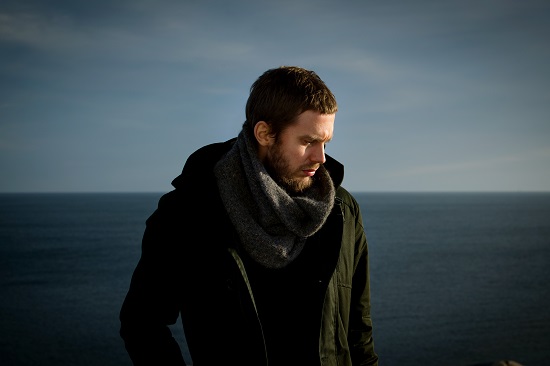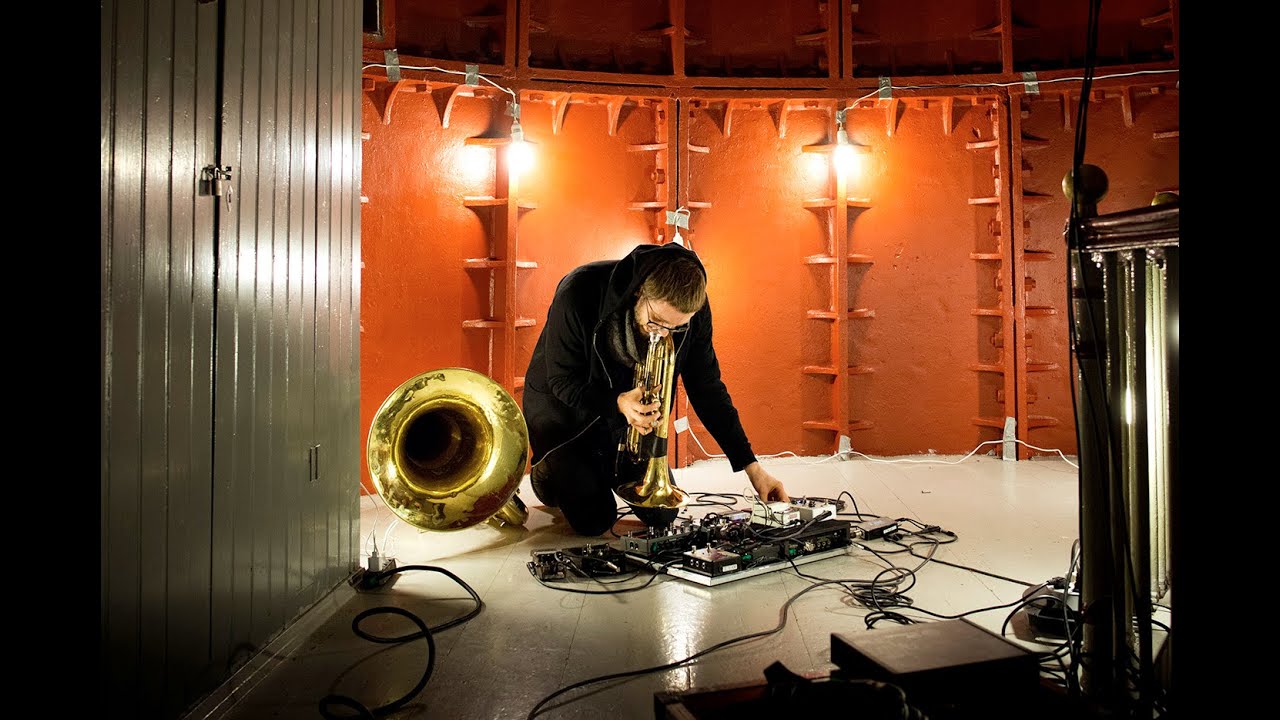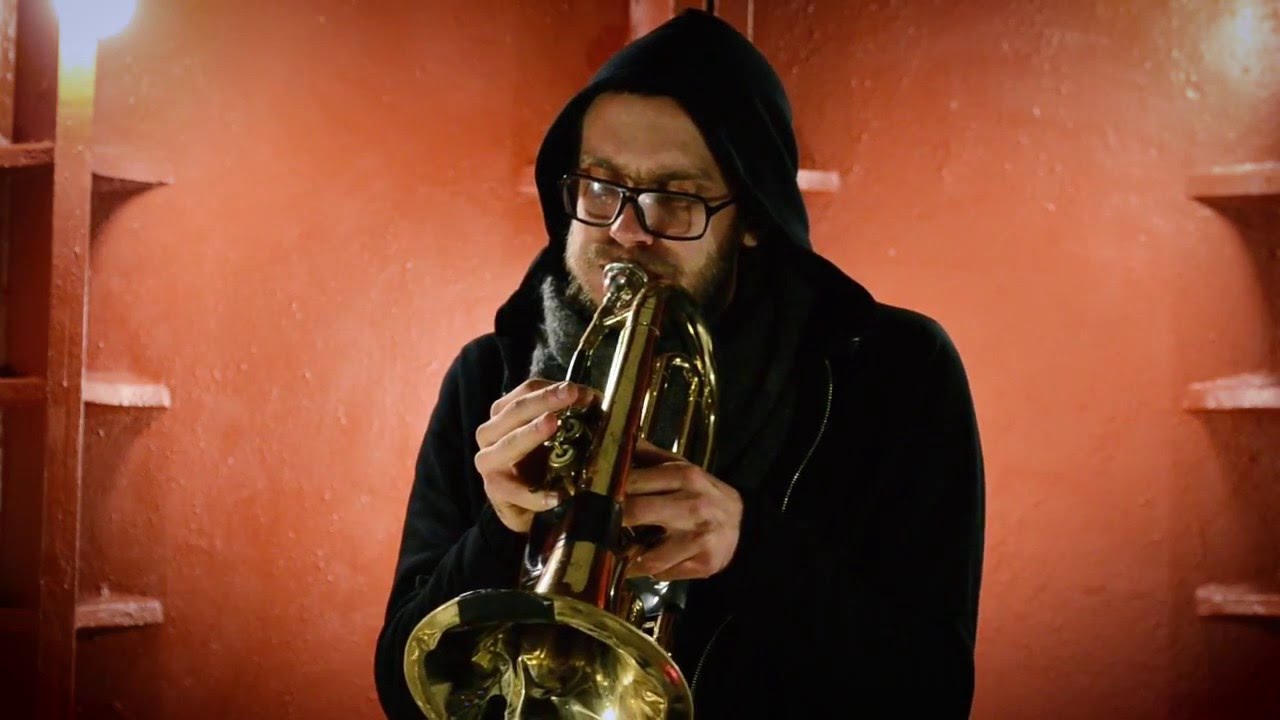Photographs courtesy of André Løyning
When I speak to Norwegian musician Kristoffer Lo, he has been on the promotional treadmill for weeks. He plays brass, guitar and percussion for, Highasakite, a pop-leaning indie rock group who are extremely popular back home. Their third LP Camp Echo (the follow up to the number one album Silent Treatment from 2014) will be released a few days after our interview and label Propellor are keeping him busy. He seems glad to be able to take some time out from his duties on this score to speak about his second solo album, The Black Meat.
On the surface of it the two projects are markedly different. Kris laughs nervously when he recounts returning to the Ryvingen Lighthouse where he recorded The Black Meat – a drone album played on tuba and flugabone. He travelled back to the remote structure in June 2015 to perform for a small audience. Only 30 people could attend the gig because of the size of the building and its inaccessibility but of the lucky few, four were Highasakite fans. He says: “There were two young girls… only about 12 years old. They got scared [by the music] and left. So I’m not always sure how well my solo music translates from one crowd to another. But on the other hand I have received tons of praise from other fans of the band, who contact me via the Highasakite website.”
Personally he doesn’t see the two things as being completely removed from one another and draws parallels in process that perhaps won’t be immediately obvious to all listeners. He considers his solo work as being music that there isn’t space for in Highasakite and thinks of the projects as bouncing off one another; with him always trying to add a noisier edge to the pop band and a more melodic edge to the heavy abstract drone work.
And there is a discernible ‘pop’ element to The Black Meat – it is bright, dynamic and melodic as well as being highly textured and rich. These are perhaps unusual sonic aspects for the field and are more likely to alienate self-identifying serious-minded older listeners rather than 12 year olds in my opinion. Which is a shame for the old folk really.
For Lo is a serious musician who openly declares that music should be fun. The 31-year-old has played on over 40 albums that range from modern classical to hip hop via pop and indie but for his solo work he seizes on non-standard opportunities for recording as they arise and then applies his extensive training to them. (He won his country’s top scholarship to study at Trondheim Jazz Conservatory in 2013 and was recently nominated for a Norwegian Grammy for his efforts.) His first LP, Anomie, was recorded in a stately home cum farm (he dismisses his own press release which refers to the building as a castle) in France with Tom Waits producer Oz Fritz. The album consists solely of drones recorded on the tuba, captured in the building’s cavernous rooms and stairwells.
He followed this up at the lighthouse at the suggestion of filmmaker André Løyning, who wanted him to take advantage of the building’s rich resonant potential. It took a 20 minute boat ride to get to the rocky island just off the southernmost tip of Norway and then a lot of concerted effort by Lo to get all of his amps and instruments 600 metres up a steep slope to the functional but unmanned lighthouse itself. The visit was initially just so that Løyning could make the Foghorn film but the music proved so memorable that it has now been released as an album in its own right.
Lo increased his tonal palette by adding a flugabone – a compact marching band brass instrument – to the tuba and played all night through an impressive array of amplification as a storm raged outside, with the rough weather conditions feeding back into the process in completely unexpected ways.
And what an album it is… Just when you think you’ve heard all you want to hear (or need to hear) from the drone genre, another unexpectedly brilliant piece of music swoops in out of the wide blue yonder. Add this to the forthcoming Centres by Ian William Craig on Fat Cat and the recently released One by the Be collective on Rivertones, and it becomes clear that 2016 is yet another great year for drone music released at the periphery.
We’re talking about your new album The Black Meat which was recorded in a lighthouse. Can you tell me a bit about this structure please?
Kris Lo: It’s called Ryvingen and it’s the southernmost lighthouse in Norway and it’s off shore so you have to take a twenty minute boat trip to get there. The nearest city is Mandal. The island is very steep and rocky. You enter at ocean level and then have to walk up 600 metres of steep, steep hill to get where the lighthouse is. There is a big house where you can sleep and a shed with tools in it and then the lighthouse itself.
The idea was that Andre wanted to make a film about me and he wanted to film it out there. We’d spend three days out at the lighthouse and film me playing during a storm.
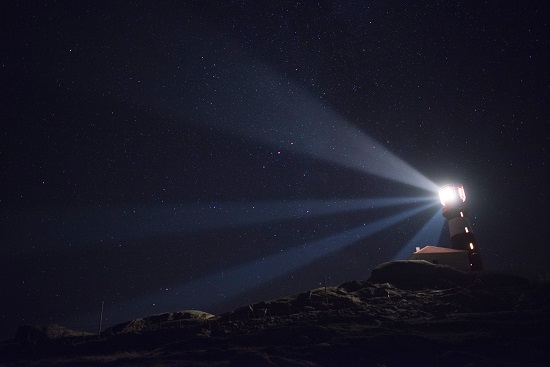
So you only used two instruments, the tuba and the flugabone?
KL: Yes. Everything is recorded live. There are no overdubs and no cuts.
Can you explain what a flugabone is?
KL: It’s not the same as the flugalhorn. The flugabone is actually a trombone that is just squeezed together and it has valves instead of a slider. It’s mainly used in marching bands in the US, where you don’t want to have that large space in front of the trombonist for the slide. So it’s a short, valve trombone mainly used by marchers. For me, I’m a trained jazz tuba player so you always have this interest in playing other similar horns but when you take an instrument like the trumpet, the mouthpiece is so small it’s actually difficult to play. But the flugabone has a mouthpiece that is only slightly smaller than that of a tuba so it’s similar to play but it has a completely different range and is so much easier to carry around. I just bought it randomly off eBay and started playing it. It’s the horn that I play for Highasakite and I’ve probably played it on 40 different albums.
Can you tell me about the decision to use just two instruments which are complementary but not a million miles away from each other in sound; and why you decided not to add any other elements such as electronics.
KL: It’s quite interesting because my first solo album was just recorded using tuba and bunch of pedals because that felt most natural back then. When I recorded this one I was so into playing the flugabone and only using the tuba as a bass instrument. Prior to that I would use the tuba for bass and melody. Now I have separated the two things; bass on one instrument, treble on the other but just brass. There are no other instruments. And for the next album which hopefully will be released in September I recorded with Steve Albini in Chicago, I played guitars for the first time. So the third has tuba, flugabone and guitar. So there’s a development going on. I was on tour with Highasakite and Monsters And Men and suddenly realised we had a day off in Chicago. So I quickly sent an email to Electrical Audio with no real expectations asking if Steve was available and he got back saying, “Yeah, I have the day off.” I called a contact at Chicago Symphony Orchestra and arranged to borrow his tuba. So I took all of my equipment in a taxi out to Electrical Audio and spent six hours recording a new album with Steve Albini, collected the mastertapes and then went straight back on with the rest of the tour.
How difficult was it, not just for you but for André as well, to get all of the gear for the film and the recording up to the lighthouse?
KL: Well, it was difficult for me because I was doing all of the carrying and André was just walking up and down filming me doing all of the carrying. He was like, “Oh yeah, this is a great shot. Oh, I need to get this shot for the film…” It was pretty rough. We had two barrows but we had three amps… huge Ampeg stacks… my tuba… so much stuff. It took two hours just to carry the stuff from the boat to the lighthouse. And then I had to carry it all up the steep steps inside the lighthouse as well. But it became part of the whole experience.
When I was a kid I used to play euphonium which, as you know, is a couple of steps down from a tuba but still a pretty big instrument for a child to be lugging about. So I feel your pain. I was having to carry my euphonium to church a couple of times a week before I was in long trousers. How did you even end up playing the tuba though, instead of, I don’t know, the guitar or piano?
KL: It was random. My interest in music has been high since day one and when I was younger I wanted to join a marching band. I really wanted to play the flute and the alto-saxophone, which are both relatively small instruments. What happens in Norway is you write up a wishlist of what you would like to play. So I wrote those instruments down on the list. But one Saturday night on TV the Norwegian Tuba Association had 76 tuba players on Norway’s biggest TV show playing a song called ‘76 Tubas’. And I was just like, “Wow!” The audition for the marching band was held the day after this broadcast and the conductor took advantage of me having seen this programme, and needing a tuba player he said, “You don’t want to play the tuba by any chance do you?” And I was like, “Yeah! Definitely!” I’ve had several occasions since where I’ve regretted watching that programme but still, I feel like I’ve taken the tuba in so many different directions and used it in so many different ways, that I feel really at home with the instrument now; so it feels right to me.
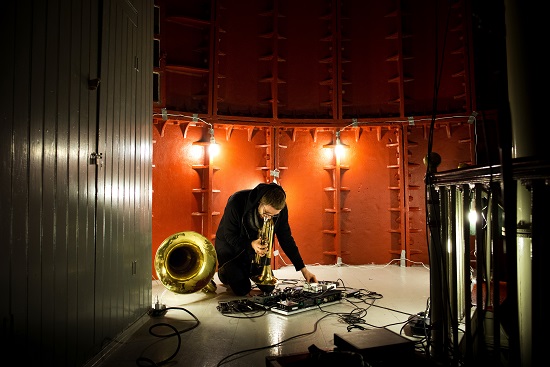
Can you tell me about the actual recording and how things like the resonance of the space and the actual storm influenced the music?
KL: It was really interesting because like most people, I hadn’t actually spent a lot of time in a working lighthouse previously. I actually had to take my tuba and play it as I was walking up and down the stairs just to check how it would resonate and to determine which floor I would play on and where to put the amps. I ended up placing the bass amps on the ground floor, guitar amps on the second floor with me sitting and playing on the third floor. Also I had mics on the ground, first, second and third floors. The resonance inside that lighthouse when I started playing through the amps was just insane. I thought the whole building was going to break apart and fall down. It was literally trembling and there was dust flying around in the air. And what with the storm going off outside, it was just crazy. It was really, really powerful and strange being in the middle of it all. It’s funny when I listen back to this recording and then when I listen back to the recording I did with Steve Albini last year, there is such a difference in the sound. The lighthouse affected the sound in so many different ways and you can hear the storm taking the building at resonating the sound into the microphones.
The album title The Black Meat is very provocative and I believe it’s a quote from Burroughs’ The Naked Lunch?
KL: I’m a huge William Burroughs fan. For me when I read Naked Lunch, I felt inspired. I like artists who ignore the normal rules about how you are supposed to see things and how you are supposed to write or create. The black meat is a reference, I think, to heroin, in that you know it’s not good for you but you have to have it. Or at least that is my interpretation of it. Now I don’t have any knowledge or experience at all of being an addict, so I just took that idea and transferred it to the way the western world operates. The way we take food and oil and resources and water and the way we don’t want to change anything about how we live right now, we aren’t willing to alter how we live. We overindulge in all this wealth. We know it’s not good but we can’t stop ourselves.
So! Full disclosure to the readers… we’ve played a gig together in a tiny sailors’ chapel called Petter Dass, on a craggy outcrop on the Traena archipelago just on the Arctic Circle off the north western Norwegian coast, which was very memorable for me. Have you played any other non-standard venues or do you have any in mind?
KL: I’ve done a couple of cool things. Do you know Zu? Well, I played with them when they were in Trondheim in March. Being on stage with those three was pretty cool. Also I’m playing on their new record. As for places I’d like to play, well the Mausoleum in Oslo is an obvious choice but so many have made recordings there already so I’m not sure. Also you have the Nidarosdomen Cathedral in Trondheim that Mayhem wanted to blow up, that has a ten second resonance time but that as well has been used for a lot of recordings. I have been thinking a lot about the indoor swimming pool in Trondheim because underneath that where all of the engines are there is this huge space with weird resonances inside it. Also, I have no idea how it would sound but there are a couple of locations up at the university. One is the old building which has a huge ceiling with a gigantic stairwell but also in the acoustics department they have an anechoic chamber. I haven’t been in there and I don’t know if I could stand to be in there but I would like to see what happens when you try to record very loud music in that environment.

